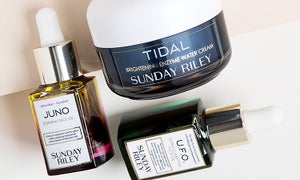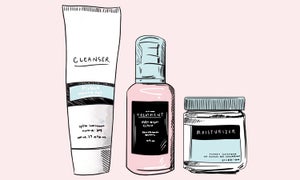
Knowing your skin type is key to making your skincare work in your favor. That’s because if you’re using skincare products that aren’t formulated for your skin type, whether dry, oily, sensitive, normal, or combination, they won’t target your skin’s specific needs and combat the issues at hand. Each skin type comes with its own challenges, and using the wrong skincare products can lead to more skin problems, which no one wants. But a simple skin typing test can point you in the right direction, especially if you’re wondering, “How do I determine my skin type,” so that you can devise and follow an effective skincare routine.
Table of Contents:
The Skin Type Self-Assessment
Not all skin is the same, but all skin falls into one of five major skin type categories. One of the most important things to know about your skin is its type. Determining your skin type, defined by genetics and how much oil it produces (although other factors can affect it), will help you find the most appropriate skincare products so you can properly address your most pressing skin concerns.
The skin can experience dips and increases in oil and dryness, especially as sebum production changes throughout the year and over time. The weather, environmental exposure, and even your skincare products can affect skin type, so it’s essential to understand your skin type. It’s also normal for some people’s skin to slowly transition from oily to dry as the skin begins to age.
There are a couple of ways to identify your skin type. For starters, you’ll always want to start at baseline and consider your skin as a whole and not look at an isolated incident, like a stand-alone breakout or winter-induced dryness. Then, use one of these skin-typing self-assessment tests to help you determine your skin type.
The Bare Faced Method
This is the easiest test since it only requires a visual assessment of your skin post-cleansing.
- Wash your face with a gentle, mild cleanser. Rinse clean, and don’t apply any other skincare products.
- About 25 minutes after you have cleansed and dried your face, examine it and feel how it looks and feels.
- If the skin feels dry and tight, it is likely dry. If it appears shiny or greasy, it is oily. If it has signs of oiliness and dryness, you have combination skin. If there are no signs of oiliness or dryness on the skin, it is normal.
The Blot Sheet Method
This method is a great way to determine how oily—if at all—your skin is.
- On not-freshly-washed skin, press a tissue or blotting sheet onto several areas of the face, including the T-zone.
- Hold the sheet or tissue to natural light and assess how much oil was absorbed.
- If you notice a lot of oil, your skin is oily. If there is minimal oil, your skin is combination. If there is no oil, your skin is normal or dry.
When assessing your skin type, it’s always best to perform one of the skin type tests on the skin at various times to get an accurate read. So, if you test it first in the morning, try it again at the end of the day or even at night because the skin is influenced by several factors throughout the day.
Different Skin Types
Dry Skin
Dry skin lacks water in the outer layers, resulting from genetics, diet, the environment, hormonal changes, using the wrong skincare products, and aging. When dryness occurs, the skin feels tight, itchy, flaky, and peely. In more extreme cases, it can feel uncomfortable and rough.
When the skin is dry, it craves hydration, but it can also be sensitive to some products, which is why finding and using those made specifically for dry skin is essential. Thick moisturizers formulated with humectants, which bind to water to pull it into the skin, are beneficial for dry skin. Commonly used humectants in skin care include ceramides, glycerin, peptides, and panthenol can help reinstate hydration into the skin, especially when used morning and night. To help seal the moisture, you’ll want to apply hydrating products, like creams and oils, to the skin when damp.
Oily Skin
Oily skin can seem like an oil slick at times, but what's happening is the skin is constantly pumping oil out due to overactive sebaceous glands. Oily skin appears shiny and sometimes greasy, and an excess of oil on the skin can cause clogged or enlarged pores and contribute to breakouts. While the heat can kick oil production into overdrive, hormones and stress are common culprits.
It’s best to wash oily skin twice daily to keep it under control. Reach for noncomedogenic and oil-free skin products, especially when it comes to creams and lotions. You’ll also want to look for skincare products with oil-controlling ingredients and salicylic and glycolic acids, which keep breakouts at bay. Lightweight gels and water-based products are always a safer bet for oily skin than rich, heavy creams, and the same goes for heavy skincare ingredients like shea butter, mineral oil, and petrolatum. Clay masks are a must since they help absorb excess oil without drying the skin.
Combination Skin
Combination skin is exactly what it sounds like, a combination of oily areas, mainly on the T-zone, and dry spots, like the cheeks. Often, combination skin experiences an uptick in oil production due to the weather, so it can be oilier in the summer and drier in the winter and fall. Since combination skin teeters between two skin types, it’s essential to use the right skincare products for this skin type so the skin’s balance and moisture levels are not disrupted.
It’s critical to use gentle cleansers that won’t strip the skin or rev up oil production to keep combination skin happy and functioning optimally. Some people with combination skin prefer to use two different cleansers to cater to the skin as needed: a hydrating one on the cheeks and one made for oily skin on the T-zone. The same rule applies to moisturizers—you’ll want to use a lightweight gel moisturizer on the T-zone and a creamier, more hydrating one on the cheeks so that the skin doesn’t fall out of balance. Just like oily skin, combination skin tends to respond well to oil-free and noncomedogenic skin care products, and blotting papers and mattifying products can be a skin savior for this skin type.
Normal Skin
Different skin types have different needs and issues; with normal skin, there’s little to worry about in the oil and moisture departments. Usually, with this skin type, the amount of oil produced is minimal, and the degree of dryness is low, making normal skin types one of the easier types of skin to treat. Normal skin is considered the ideal skin type, with few imperfections, redness, and breakouts, if any, and can serve as a skin benchmark.
Even though normal skin may not be riddled with many skin issues, it’s still important to take care of it. A well-rounded skincare routine that consists of the basics—a gentle cleanser, moisturizer, and sunscreen—is a must. You can also add other skincare products to prevent common signs of aging or for added protection, but anti-acne, anti-redness, and calming ingredients aren’t usually necessary.
Sensitive Skin
If your skin is easily irritated and becomes red on the drop of a dime, you may wonder what your skin type is; chances are it falls under the sensitive skin category. How to identify your skin type if it veers on the sensitive side shouldn’t be a game of trial and error when it comes to skincare products (although, for many people, it is). The first sign of redness, bumps, irritation, burning, stinging, or discomfort, whether when using skincare products or experiencing these symptoms on bare skin, should raise a flag that sensitive skin is likely the reason for intolerant skin.
Since sensitive skin is easily triggered to react by the environment, a disruption in normal pH levels, and harsh ingredients, it’s super important to be mindful of what your skin reacts to. You’ll also want to pay close attention to the ingredients in your skincare routine since the wrong ones can easily trigger it to react. To keep your skin clear, stick with gentle, fragrance-free, paraben-free, and hypoallergenic skincare products that are made without dyes or alcohol and have calming, anti-redness, and anti-inflammatory ingredients, too. Using pH Balanced skincare products that are lightweight and with a cooling effect can also help soothe the skin in the event of a flare-up.
Other Skin Types
In addition to the five main skin types, there are also subcategories of skin types. It’s important to consider these additional skin types, which also fall under one of the overarching skin types, to help clear up and mitigate common issues. If you are curious about how to find out your skin type outside of the primary ones, assess your skin in its most current state, and you can easily determine if it falls into one of the following categories.
Aging skin
Unfortunately, all skin types succumb to the natural aging process no matter how diligent you are with your skincare routine and what kind of skin you have. Integrating anti-aging products into your routine, regardless of skin type, is vital for youthful skin. Work at least one collagen-stimulating product into your routine to keep the skin healthy, plump, and elastic, whether vitamin C, peptides, or retinol. Ingredients like these can signal the skin to make collagen naturally and give the skin a firming and plumping effect. A good anti-aging moisturizer is also a must, but make sure to pick one compatible with your skin type to avoid adverse effects.
Acne-prone skin
If your skin breaks out easily and regularly, it’s acne prone. While acne-prone and oily skin go hand in hand, acne can accompany any skin type. Many factors contribute to acne, ranging from stress to genetics and even diet and skincare ingredients, so you’ll want to be mindful of the ingredients in your skincare products and steer clear of anything that clogs the pores. Acne-prone skin still needs regular moisture—so don’t skimp there—but make sure you use products formulated specifically for this skin type. Other must-includes in a skincare routine for acne-prone skin include retinol, salicylic acid, benzoyl peroxide, and a regular exfoliator.
Mature skin
Like aging skin, which can start to show its first signs as early as your 30s, mature skin is categorized by skin in its mid-50s and beyond. Since different skin types age at different rates, it’s essential to pay close attention to your skin’s needs as it changes since mature skin may transition from one skin type to another (oily skin to dry skin, for example). With mature skin, more extreme signs of aging are noticeable like deeper-set lines and wrinkles, a loss of elasticity, rough and dry skin and even dehydration, and stubborn spots and discoloration. Products that protect mature skin against environmental aggressors, which can further damage this more delicate type of skin, are critical to use, as are collagen-stimulating ingredients and those that speed up the rate of cell turnover.
The Bottom Line
Knowing how to identify your skin type is step number one in the quest for healthy, youthful skin. That’s because if you’re not using the right skincare products for your skin type, all your efforts may be null and void—plus, you can end up creating skin issues that don’t exist, too. Rather than taking an experimental approach to your skincare routine, determining your skin type first will help you select the right skincare products to make a difference. From there, you can assess your skin as needed since it's likely that your skin will change throughout your life, and you’ll want to ensure that what you’re using is still beneficial to your skin.
Click here for a complete list of our favorite skincare products for each skin type.

Related Articles





